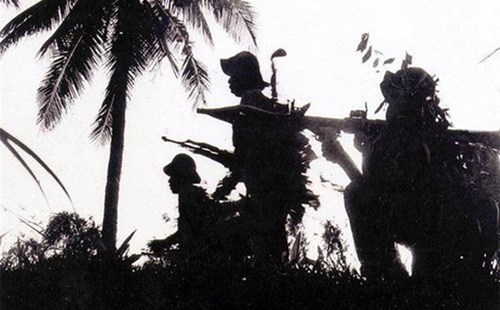Ideal weapon for city battles
The battles during the Mau Than Tet Offensive mostly took place in cities and towns in close combat ranges with lots of shelters and obstacles. As always, the AK rifle was one of the most effective and important weapons that the Vietnamese soldiers used to fight in these special combat characteristics.
    |
 |
|
Vietnamese troops joined battles with AKs and B-41s. A filed photo |
The AKs, designed to resist mud, soil, and water, matched well with the Vietnamese environment. In the hands of the Vietnamese soldiers, these rifles left the mountains and jungles, full of obstacles and difficult to access, for battles all over the South, moving across the Huong River to occupied battlefields in Hue City, and following many secret “corridors” for the Saigon commandos to attack the very headquarters of the U.S. and the Southern puppet regime.
The AKs have a typically loud and trenchant sound, creating psychological effects on the enemy. In the hands of an experienced marksman, the sounds of two consecutive rounds become more thrilling. The AK’s 7.62 mm bullets, which have a high level of destruction, can go through brick and wooden walls, the typical obstacles of cities.
The typical AK model at that time was the one with the fixed wooden butt. The wooden-steel butt was durable and useful for hand-to-hand combats. The AK’s type 56 was mounted with a three-edged bayonet, making it a more effective in hand-to-hand combats. Less popular were AKS and AKMS, whose butts could be folded to make them easy for transport and combat in limited space.
In battles to take each room and street, AK rifles were special and suitable with the tactics termed “clinging to the belt.”
Small pistols, big power
Operating undercover amongst the enemy created the demand for weapons that the commandos or spy agents could hide easily. Pistols were the optimum choice and TT-33 was the best option.
Introduced in 1930 by the Soviet Union, TT-33s were then manufactured by many socialist countries. The TT-33 was named K-54 when it was used in Vietnam. Senior Colonel Tran Van Tau, alias Tu Cang, Hero of the Armed Forces, Head of the H-63 Spy Network, used a K-54 to shoot down two U.S. officers when the Saigon commandos assaulted the Independence Palace.
The K-54 has small and light bullet but the velocity was higher that other U.S. pistols. Its bullets can penetrate from long distances, for example, the steel helmets and the standard bullet-proof vest issued for the U.S. soldiers at that time. Therefore, with their reliability and accuracy, K-54s were a good choice for commandos and spy agents.
Portable “artillery”
The preparation of explosives, grenades, and portable grenade launchers for the campaign was given first priority as they were very effective in city battles.
The most popular grenades used in the campaign were F1s and RG-42s. These “duck beak” grenades were small enough to hold in the palm. Another older version, the pestle grenade, was also used because the handle of this type helped soldiers to throw them further.
The most powerful hand-thrown weapon in this campaign was the offensive grenades that were designed like a compact explosive box. Variant in their volume, an offensive grenade could be as powerful as a normal grenade or could destroy the enemy’s concrete walls or trenches. Moreover, the sound of offensive grenades was also often a signal of a surprise attack against the enemy targets.
Importantly, the weapon that caused the most damage to the enemy was RPG. During the campaign, the Vietnamese forces used the RPG-2 (B-40) and a smaller, more modern one, the RPG-7 (B-41).
The B-40s were introduced in 1949 with the effective range of 150 meters. B-40s were effective in attacking trenches, fortifications, trucks, tanks, and armored vehicles. However, the B-40 warheads were designed with a simple explosion mechanism meaning they needed full impact with a solid target, so they could be deactivated by sandbags or steel nets. That shortcoming was corrected by B-41 when it was produced in 1958.
B-40s and B-41s were effective in responding to strong firing power of the enemy as they were suitable for close combats and named “tank-killers”.
The Mau Than Tet Offensive was the first time that portable anti-tank weapons were used, creating “artillery power” right in the middle of city battles, surprising the enemy and contributing to the victories in the campaign.
Translated by Nam Long